Researchers at the University of Southern Indiana claim that businesses can cut their communication costs by more than 55% by using a VoIP provider system instead of a landline. Furthermore, landline phones require bulky on-site equipment and frequent maintenance, which limits agents to a local office, unlike VoIP systems.
Cloud-based VoIP systems eliminate the need for on-site equipment, allowing users to make calls over the internet. These networks are easy to set up, offer excellent call quality, and a wide range of connectivity options. Each company that provides this service has its own pricing plans, features, and calling zones.
We’ve ranked the 10 best VoIP providers of 2023 to help you make a more informed decision and determine which company best suits your needs.
Our Top 10 Best VoIP Providers & Services:
RingCentral MVP: Best VoIP provider overall
Vonage: Highest reliability with 99.99% uptime
Zoom Phone. Best for unlimited domestic calling outside the US
GoTo Connect: Best all-in-one solution
Dialpad: Best for small businesses looking for AI support
Grasshopper: Best for unlimited extensions
Ooma Office: Best for long call queues
Phone with web.com: Best for low-volume calls
Vox Direct: Best for SMS marketing
Comcast Business: Best for creating custom call groups for sequential calls
Our Methodology: How We Reviewed the Best VoIP Providers & Services
We use the same comparison factors to provide fair ratings for each of the 10 VoIP providers included in this review. However, depending on your business needs, some features will be more important than others. To evaluate and rank the best VoIP services for businesses, we considered the following key Voice over Internet Protocol (VoIP) system features:
- Features
- Collaboration Tools
- Communication Methods
- Queue Management and Routing
- Analytics and Monitoring Tools
- Unlimited and International Calling Coverage. Supported Integrations
- Pricing
- Easy to Use
Our 10 Best VoIP Companies & Services
1.RingCentral

RingCentral MVP is a team-focused UCaaS (Unified Communications as a Service) platform with built-in collaboration tools like VoIP calling, SMS messaging, team chat, and video conferencing.
The platform lets users invite each other via email and create a personalized phone system with voicemail transcription, call recording, and adaptive interactive voice response (IVR) menus for self-service routing. You can also create dozens of team chat channels where members can send each other messages, images, share files, and assign tasks with deadlines.
The high-resolution video conferencing can accommodate up to 200 participants and is powered by AI-powered tools. These include automatically generated insights, background noise reduction, live text conversion, and collaborative spreadsheets.
According to Emma Grotluschen, senior director of customer success at Swanson, RingCentral’s contact center empowers her entire team to improve customer service. She adds, “The reporting capabilities help us monitor and continuously improve our performance, and with automatic call recording, our managers have tripled the number of calls they can review.”
Why we chose RingCentral MVP: RingCentral MVP offers VoIP plans with a comprehensive, collaborative UCaaS platform that’s ideal for businesses large and small. All plans also include unlimited calling within the U.S. and Canada.
Our experience: We were impressed that we were able to set it up in minutes. The RingCentral app was also easy to use and allowed our team members to interact instantly across multiple media.
PROS
- Video sharing capabilities
- File management capabilities
- International VoIP numbers
CONS
- Essentials plan has a maximum of 20 users
- No unlimited international calling options
2. Vonage

Vonage is a UCaaS platform that offers VoIP, SMS, live chat, and video. These three capabilities are increasingly popular with younger audiences. Its business communications platform includes basic telephony features and collaboration tools.
Vonage, its browser, and mobile apps include standard calling features such as automatic call routing and management tools such as call storage, transfer, and parking. Queues and multi-channel business inboxes are also available as additional features.
This messaging service makes it easy to communicate between individuals and groups. Video calls include collaboration features such as whiteboards for up to 20 participants, team chat, waiting rooms, and integration with calendar apps for scheduling.
Kevin Peña, strategic alliance manager at Headphones.com, says: “Since switching to Vonage Business Communications, our team members work from their workstations—from home, the office, or both—and they can seamlessly access our VBC accounts from anywhere.” They can make and receive calls from their mobile phones as easily as they can from their desk phones, thanks to a simple and intuitive interface that keeps calls, voicemails, and messages in one place.
Why we chose Vonage: Vonage Business Communications offers simple and intuitive VoIP capabilities. All plans include Vonage Meetings, which includes voice, video, and messaging collaboration.
Our experience: We loved Vonage’s collaborative whiteboards and team messaging. Its click-to-call desktop feature was especially useful for spontaneous communications.
PROS
- Self-service functionality
- No user limits on lower-priced plans
- You can switch calls directly between devices
CONS
- Not rated
- Features included in competing plans incur additional fees
3. Zoom Phone
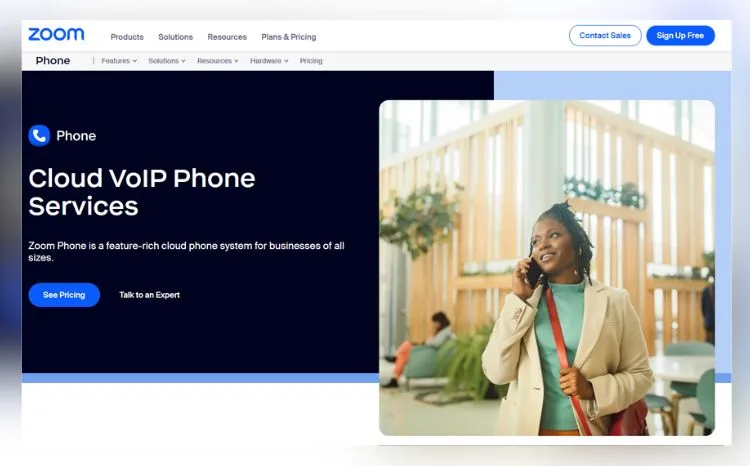
Zoom Phone is Zoom’s one-stop system for Zoom; not to be confused with its video conferencing app, Meetings, or collaboration platform, Zoom One, Zoom Phone includes team chat and integrates with Zoom One to make collaboration more accessible and intuitive for remote workers. The Zoom app, available for desktop, browser, and mobile, combines all of the company’s features into one seamless interface, but it only works with Zoom Phone.
This phone system is perfect for businesses looking for a cutting-edge phone solution without the hassle of other means of communication. The three pricing plans share the same features but differ in their limited calling area and pricing structure: a pay-per-minute plan for the US and Canada, an unlimited calling plan between the US and Canada, and unlimited national calling plans within the US (over 40 countries). Unlimited plans and add-ons allow for unlimited calling to 19 other countries. Local and toll-free Direct Inward Dialing (DID) numbers are available in several countries around the world.
The Zoom Phone system provides access to a wide range of advanced call center features. These include unlimited queues, call groups (a group of phone number extensions that are shared by incoming calls), call distribution, voicemail transcription, call recording, IVR routing, and device switching. While Zoom Phone does not offer analytics, it does offer call center monitoring through monitoring, blocking, and control. Chat and video capabilities are standard, but can be expanded to include Zoom One as a concurrent UCS platform.
Why we chose Zoom Phone: Zoom Phone offers a wide range of advanced call center features, with unique unlimited domestic and international calling options.
Our experience: We like that Zoom Phone offers affordable pricing plans and unlimited queues, but we wish it had queue analytics for greater visibility.
PROS
- Unlimited domestic plans outside the US
- Add-ons for unlimited calling in 19 countries
- Unlimited call queues
CONS
- Advanced chat collaboration requires a Zoom One subscription
- No analytics
4.GoTo
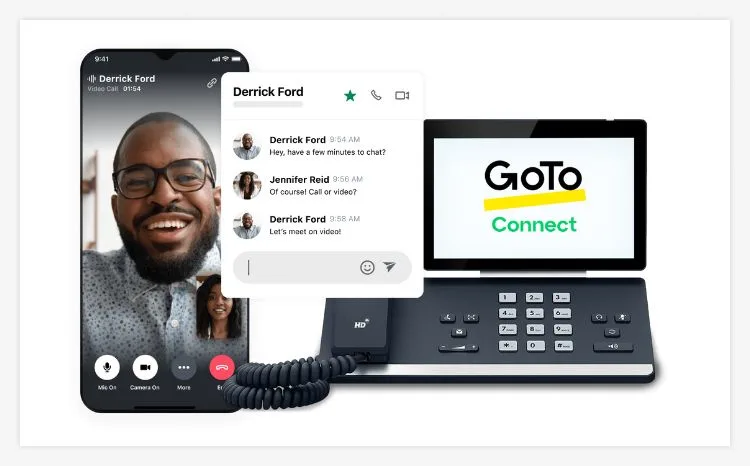
GoTo Connect is a unified communications platform and business phone system that uses VoIP calling, SMS, internal team chat, and collaborative video messaging. It offers virtual phone numbers worldwide, and all plans include unlimited calling to over 50 countries. This service allows you to answer and make softphone calls from the GoTo Connect app on any device. You can also exchange real calls and customize call routing with a drag-and-drop call plan editor to link users, voice messages, and announcements.
You can also create call groups with specific routing sequences that can be organized into unlimited call queues. The most comprehensive Premium plan includes real-time queue analytics, a dashboard with monitoring tools, and agent performance reports.
GoTo Connect HD video conferencing supports up to 250 participants with screen sharing and chat. It lets you create and schedule video meetings from within the system and link them to calendar apps. Want to start unlimited one-on-one or team chats? You can do this with one-click buttons and emoticons to join a call or video meeting, in addition to sharing files.
Why we chose GoTo Connect: GoTo Connect has one of the largest unlimited VoIP calling areas on the market, in over 50 countries.
Our experience: We appreciate that GoTo Connect includes unlimited queues and driver monitoring tools for greater visibility. We also like that the system can link scheduled meetings to many popular calendar apps, such as Microsoft Outlook, Google Calendar, and Apple iCloud Calendar.
PROS
- Unlimited call space;
- Number of calls;
- Unlimited call queues;
CONS
- The basic plan limits video meetings to four participants;
- its plans are more expensive than those of its competitors.
5. Dialpad
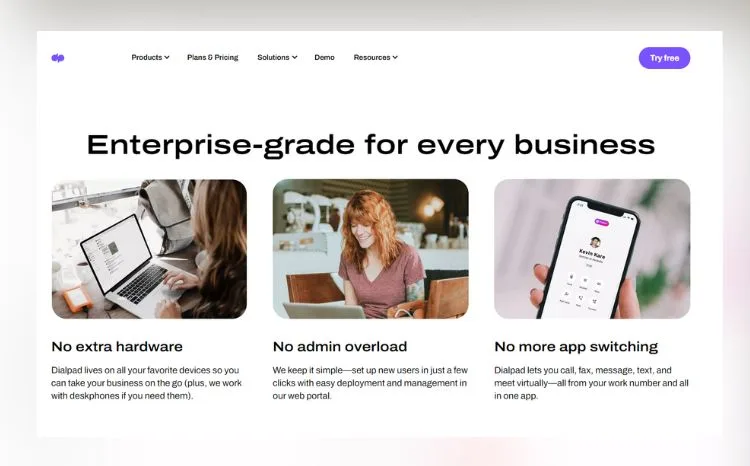
Dialpad is an AI-enhanced UCaaS platform that offers VoIP telephony, SMS, collaborative team chat, and video conferencing. Video conferencing is limited to 10 users, making this provider a great choice for small teams.
The phone system supports unlimited calling in the US and Canada, as well as international cloud numbers in over 70 countries. It includes routing and queuing features such as auto attendants, individual call distribution, unlimited queues, and call groups.
Dialpad’s main strength lies in its AI support. All calls are transcribed in real time, with automatically generated summaries that track key topics, sentiment, highlights, and actions. Agents receive real-time AI training, while supervisors can access live reports on the queue.
Dialpad meetings are limited to 10 users, but include collaboration tools like chat, waiting rooms, and whiteboards. You can use the system to schedule meetings in integrated apps like Google or Microsoft 365 and invite anyone to join without downloading the app. Keyboard chat makes it easy to access shared and saved files with a search feature.
Why did we choose Dialpad? Dialpad has several AI-powered features, like agent coaching and automatically generated call summaries.
Our experience: We like that Dialpad conferences are packed with collaboration features like transcription and whiteboards. We also think that the automatically generated call summaries help streamline the post-call process by making it easier to review what was discussed.
PROS
- Artificial intelligence support
- File management capabilities
- Available plans
CONS
- Limited number of conference participants
- Unlimited and limited call space
6. Grasshopper
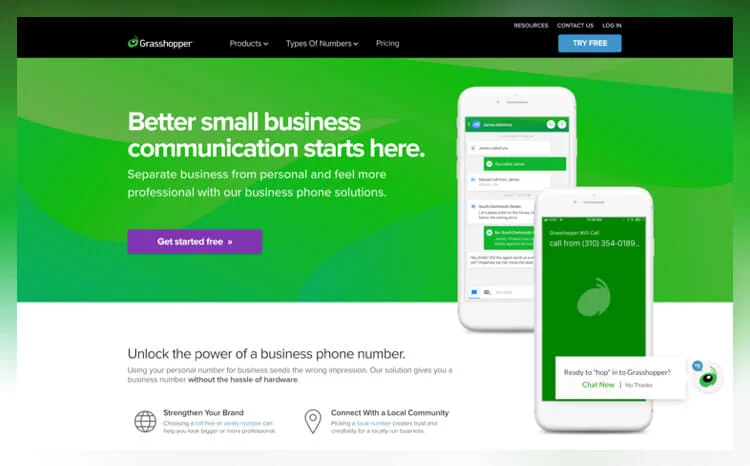
Grasshopper is a VoIP phone system that offers voice calls and SMS text messaging. Available via a mobile and desktop app, the phone system is easy to use.
These service plans offer unlimited calling within the US and Canada, and each includes a pre-set phone number limit that you can share among as many agents as you need. Grasshopper’s pricing structure is ideal for businesses that want to share multiple phone numbers across multiple extensions. However, all of its available DID numbers have US area codes.
In the Grasshopper app, agents can make calls and send SMS to anywhere in the world. They can also access their voicemail to transcribe, screen, or forward calls. Each agent can create a personalized greeting that can be configured with a Grasshopper phone number extension to create an automated attendant routing system. These plans support anywhere from three extensions to an unlimited number.
With this service, you can send text messages worldwide and configure your phone system to send auto-replies to first-time callers, busy callers, and more.
Why we chose Grasshopper: Grasshopper is ideal for those who don’t want multiple channels, collaboration, routing, or queuing. Its pricing plans are also ideal for businesses whose agents need to share phone numbers.
Our experience: We found the Grasshopper app easy to use and appreciated its messaging capabilities. Although setting up the IVR was confusing, the responsive and knowledgeable customer service team helped us complete it in less than 30 minutes.
PROS
- Voicemail
- Shared phone numbers
- Auto-attendant routing systems
CONS
- Lacks video and chat capabilities.
- Does not offer international phone numbers.
7. Ooma Office
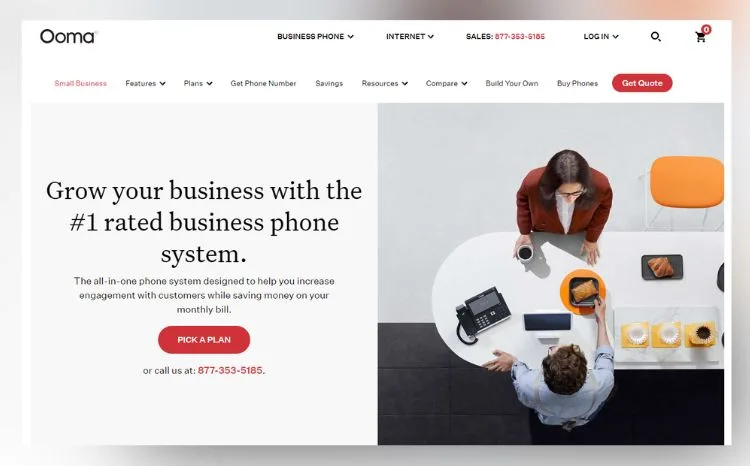
Ooma Office is a VoIP phone system and UCaaS platform with all major communication channels: voice, SMS, team chat, and video. The phone system supports unlimited calling in the US and Canada at per-minute rates to anywhere in the world. Ooma also offers local and toll-free US area numbers.
The Ooma Office app, available on both desktop and mobile devices, gives agents access to team messaging, voicemail, call logs, SMS, video, and basic call management. It also allows agents to participate in three-way conferences and transfer, park, and forward calls between devices.
Agents can create unlimited call queues, call groups, automated call recording, and self-service auto attendant routes. Administrators can view real-time and historical call analytics to gain insight into contact center performance and performance. Agents can share a single inbox when sending SMS messages, dividing responsibility for incoming text messages.
Ooma allows for individual and team messaging, and its video conferencing supports screen sharing but lacks collaboration capabilities.
Why did we choose the Ooma Office? It offers a full suite of phone system features, such as routing and queuing. It’s a great option for teams that need a platform with standard UCaaS capabilities.
Our experience: From a supervisor’s perspective, we appreciate Ooma’s analytics and queue monitoring. We also like that agents can share voice messages and that team chat is included in all Ooma plans.
PROS
- Routing and queuing capabilities
- Advanced monitoring analytics
- Team chat is included in all plans.
CONS
- No international numbers
- Very limited chat and video capabilities.
8. Phone
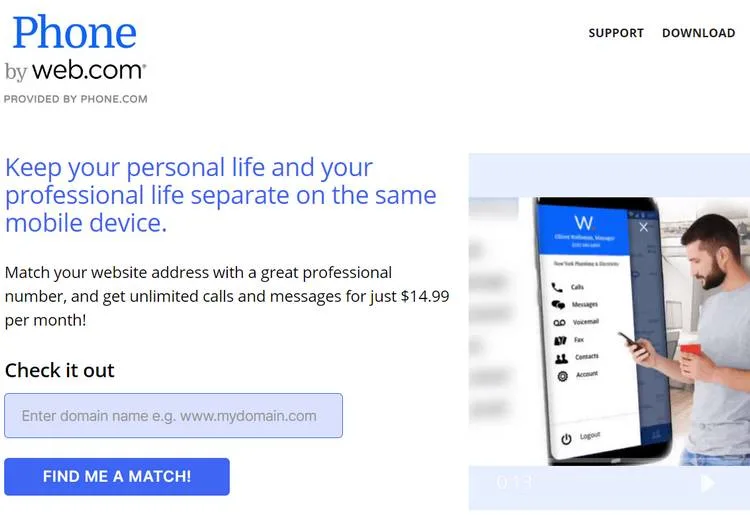
Phone by Web.com (developed by Phone.com) is a cloud-based phone system for VoIP calls, SMS messages, and video conferencing. It is an affordable platform that offers bundled minutes and unlimited calling options.
Phone by Web.com’s Basic plan offers 500 minutes of talk time and 1,000 combined text messages, while higher-end plans offer unlimited talk time and text messages in the U.S. and Canada. These more advanced plans also offer useful routing features such as interactive voice response (IVR) menus, call queues, voice message transcription, and automatic voice message forwarding to email.
Video conferencing supports up to 100 participants with no time limit. It offers dynamic collaboration features such as document sharing, screen sharing, virtual backgrounds, whiteboards, and breakout rooms.
All three Phone by Web.com channels are included in all plans, but the best collaboration features, such as call recording and department rooms, are only available in the Pro plan.
Why did we choose Phone by Web.com? Phone by Web.com offers an affordable shared minutes plan for teams with low call volume and video conferencing capabilities.
Our experience: We appreciate that Phone by Web.com integrates video conferencing features into all of its plans, with no time limits. We also like that it supports international calling with virtual phone numbers available worldwide.
PROS
- Unlimited video calling
- Call queuing features
- Whiteboard collaboration tools for video conferencing
CONS
- No team chat
- Video conferencing has a small number of participants
9.VoxDirect

VoxDirect is a VoIP phone system that specializes in voice and SMS marketing. While it doesn’t include collaboration channels like video calling or team chat, it does offer text templates and settings to enable push campaigns, notifications, and other bulk email uses.
All VoxDirect plans include a toll-free, dedicated, or local U.S. VoIP phone number. Subscriptions allow for unlimited calling within the U.S. and Canada, as well as the ability to make international VoIP calls. Each plan includes a pre-defined number of extensions and virtual receivers, allowing you to share numbers with multiple users and create a self-service customer referral system. Agents can record calls with a single click during a call and quickly transfer calls. Vox’s uVox dashboard lets you manage multiple numbers simultaneously, customize IVR, configure call recording, and access voicemail with transcription.
The Text dashboard organizes all text-related tools and features. It allows you to view your subscribers’ contact information and organize them into groups for different marketing or customer service purposes. You can also create and schedule text messages using templates (for events, promotions, news, engagement, and notifications) to create drip campaigns and communicate with thousands of customers at once. When a customer responds to a bulk or automated text message, the agent receives the response and can proceed to a one-on-one text conversation.
Why VoxDirect? V:xDirect bulk text messaging offers unique SMS marketing options, such as sales and promotion templates, autoresponders, and scheduled text messages.
Our experience: With VoxDirect’s extensive library of SMS templates covering common categories such as greetings, promotions, notifications, and standard autoresponders, we were able to easily schedule text messages.
PROS
- Text templates for marketing.
- Easily managed contact lists.
- Toll-free and personal numbers.
CONS
- Limited call analysis capabilities.
- No chat or video calling.
10. Comcast Business
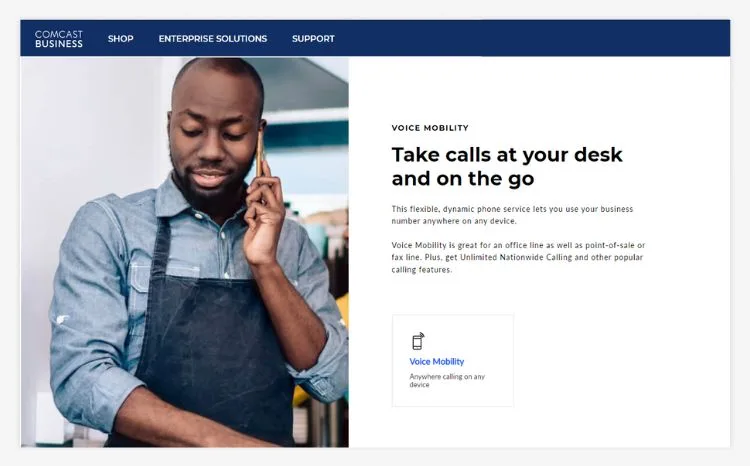
Comcast Business Voice offers a VoIP phone system that you can use on any device (mobile or desktop). It offers local numbers worldwide and the ability to port existing numbers.
The Your Business app doesn’t support messaging, team chat, or integrated video calling. However, the Comcast interface includes useful call monitoring and routing tools, such as caller ID and history, call hold and transfer, call forwarding, park, retrieve, and hold.
With this service, you can create groups with specific call commands so that users are called in sequence until someone answers. You can also set business hours and forwarding rules, where each agent has a virtual voicemail with a personalized greeting, transcription, and one-click callback.
Why did we choose Comcast Business? Comcast Business allows you to purchase SIP and PRI trunks to add phone lines or to completely migrate to an on-premises VoIP system. Additionally, if your business wants to migrate from an older PBX system that connects its phone system to users via landline cables, Comcast can help with this transition.
Our experience: Comcast Business made it easy to migrate from a basic landline phone system because it didn’t require us to learn a new interface or use new tools.
PROS
- Easy-to-use app interface
- Variety of call management options
- Group call scheduling
CONS
- No chat, SMS, video, or analytics
- No built-in IVR functionality
How to Compare the Best VoIP Providers & Services
To differentiate the best VoIP providers, consider several factors, such as your budget, your collaboration needs, your most used channels, your call and message volume, your manager and call center monitoring needs, and your most frequently called destinations.
Then, evaluate and compare potential VoIP service providers based on their features and price. The most important VoIP features are call distribution, auto attendant menus, caller ID, video conferencing, SMS text messaging, and file sharing.
The following table describes the main features and methods you can use to determine which provider best suits your business needs.
What Is VoIP?

Voice over Internet Protocol (VoIP) is a telephone service that transmits voice data over an Internet connection, rather than sending signals over a traditional landline. VoIP is a more portable option because users can access their phone features from anywhere with an Internet connection. These systems are commonly used to:
- Manage incoming and outgoing calls in a call center.
- Participate in calls and video conferences.
- Conduct distance learning courses.
- Offer telemedicine services.
- Call colleagues, friends, or family members who live in different countries.
How Does VoIP Services Work?
VoIP works by converting a speaker’s data into data packets and sending them over the Internet to recipients anywhere in the world. A company signs up with a VoIP provider. its agents have access to a computer program or browser that connects to the Internet. When an agent speaks over the Internet, the program transmits the voice data to a provider, usually located in the United States. From there, the system sends the voice through an international chain of networks and servers until it reaches the recipient.
If the agent dials a VoIP number, the call is transmitted entirely over the Internet. However, if they call a mobile phone, the VoIP data is converted to 4G or 5G cellular data before it reaches the terminal. If the number dialed is a landline, this data is converted to voice over the public switched telephone network (PSTN).
What Is Business VoIP and How Can It Help Your Business?
Business VoIP solutions use the same voice transmission process as traditional VoIP, which involves sending data packets over the Internet. However, they are designed to meet the needs of your business.
Many businesses prefer VoIP phone systems over traditional on-premises PBX systems because they offer more benefits, such as:
- Quick installation
- No hardware maintenance
- Scalability
- More communication channels
- Establish a global business presence
- Internal collaboration options
- Better customer service
- Improved call quality
- Agent mobility
- Maintaining a unified business identity with a remote team
Another reason VoIP is so attractive is that it allows agents to collaborate more effectively, use workflow tools and A.I. support, and communicate with customers across multiple channels, all from a single app on any device they have internet or mobile access. Service.
How to Internet Best Business VoIP Services
Before choosing a VoIP provider, compare how well each one fits your business needs. These steps will help you conduct a detailed comparison and determine the system that best suits your needs.
- Consider your business needs. Determine your budget, desired features, preferred communication channels, the level of collaboration your agents require, and the geographic areas you frequent.
- Compare collaboration and multichannel capabilities. See what communication methods each provider on our list offers. Explore their pricing plans, video conferencing and team chat collaboration capabilities, and additional agent support tools like live call streaming or voice coaching.
- Evaluate unlimited calling zones. Review your logs and call volume to determine which destinations your agents call most frequently. If you make frequent international calls, consider providers with low global rates or unlimited calling zones to multiple countries.
- Determine your desired geographic footprint. Consider where your customers are located and decide if you want to expand your reach into those areas. Look for a service provider that offers virtual DID numbers in the regions where you want to establish a local presence.
- Compare routing and queuing capabilities. Assess the size of your call center, including the number of agents, supervisors, and departments. Determine whether you need to route incoming calls to multiple departments—sales, marketing, accounting, customer service, and so on. Then compare each provider’s service and queuing offerings, such as call groups, auto attendant lists, skills-based routing, and direct queuing—and discuss them with your managers.
Essential Features of VoIP Services You Must Know
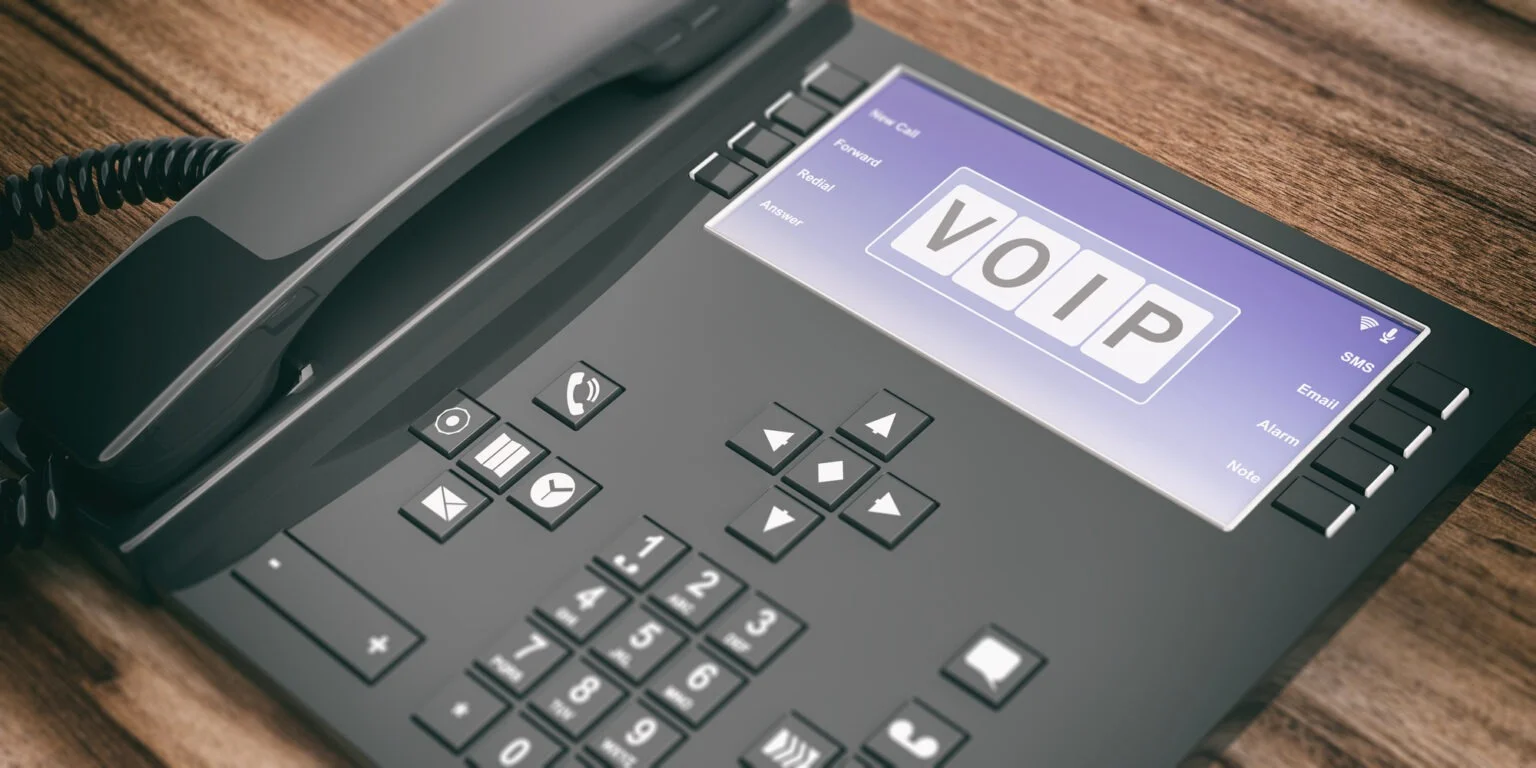
The most important features of VOIP include multiple communication channels, call routing, IVR and auto attendants, call queuing, analytics, call recording, and transcription.
Communication Channels
Most VOIP companies focus on internet voice calls, while UCaaS platforms offer up to four virtual communication channels: phone, SMS, video conferencing, and team chat as a single product. Phone refers to VoIP calls, SMS allows you to send and receive text messages, video conferencing allows agents to participate in video conferences with customers, and team chat allows you to send personal and web messages.
Call Routing
Sometimes called automatic call distribution (ACD), routing occurs when you configure your phone system to route incoming calls to specific users based on predefined routing rules. For example, IVR self-service menus allow customers to be directed to the right user or department by selecting the option that best suits their needs. Skills-based routing (SBR), on the other hand, routes customers to the right call based on their required skills, assigning them to the agent with the most relevant skills.
Call Queueing
When incoming calls reach a busy agent, call queues place the customer in a queue based on the call received. Agents can view the calls in their queue and choose which one to handle. Some systems also offer call groups, which allow multiple agents to share queues and responsibility for incoming calls.
Analytics
Telephone system performance and usage statistics and metrics can provide insight into queue activity, agent performance, and call quality. Analytics include reports, graphs, charts, graphs, and data that can be sorted by specific historical time periods.
Call Recording
Call recording allows you to record calls for storage, sharing, and review. You can choose between automatic recording, where all calls are recorded, and on-demand recording, where only specific calls are recorded.
Transcription
Transcription, where artificial intelligence systems convert the audio of phone calls or voicemails into text or subtitles, allows these systems to identify customer sentiment, create call summaries, and provide real-time agent training.
Call Management Features
Call control features, called ACD or call routing, allow you to configure your phone system to route incoming calls to specific agents according to your defined rules. (This feature is similar to our previous example, self-service IVR and skills-based routing.)
Mobile Compatibility
A VoIP phone system must be compatible with mobile devices, desktop computers and browsers. Typically, most VoIP features (such as analytics, call management, team chat, and even video conferencing) are available on all devices, including mobile platforms such as iOS and Android.
Integrations
A VoIP phone system should integrate with your business applications. Some VoIP providers, such as RingCentral and Dialpad, integrate with dozens of other applications, allowing you to use their features directly from within the other application and vice versa. Useful CRM integrations include platforms like Salesforce, calendaring applications like Google, and collaboration applications like Slack.
Collaboration Tools
In addition to calling, many VoIP providers offer collaboration features that agents can access directly from the system application. These include team chat rooms (which allow users to create topics, share files and images, and assign tasks) and video conferencing (which utilize collaboration tools like simultaneous whiteboarding, screen sharing, and live polling).
Additional Numbers
VoIP providers typically include a DID number with each user registration. However, they also allow you to purchase additional VoIP numbers. You can add numbers with area codes from anywhere in the United States. Some providers even have virtual numbers for countries around the world.
Video Conferencing
Many VoIP providers offer video conferencing as a means of communication. Agents can join internal team video conferences to collaborate or send invitation links to customers. Each provider offers unique features, time limits, and collaboration tools for video conference participants. Video conferences typically accommodate up to 200 participants, last 24 hours, and offer features such as chat and screen sharing.
IVR
An IVR, also called an automated attendant, is a self-service telephone menu that customers can use to contact specific agents at your company. Most VoIP providers allow you to create your own IVR menu using a chat type or custom recorded messages to offer different options, such as “D” al “” “S” les” and “s” “n” options.
Key Benefits of Using Business VoIP Phone Service Providers
The key benefits of using a business VoIP phone service are scalability, affordability, versatility, multi-device support, excellent voice quality, advanced features, remote installations, and global availability.
Scalability
VoIP virtual phone providers allow you to switch users within minutes, no matter where they are, without the need to install new phone connectors or desktop computers. This means that when your company wants to add or remove agents, it can do so with just a few clicks. In contrast, traditional internal PBX systems require the addition of new physical phone lines and the purchase of new equipment, making it difficult to onboard new users.
Virtual phone providers offer very flexible subscription plans that allow you to add and remove users just as quickly. You can also expand your business globally by purchasing VoIP numbers in countries outside your local area. This scalability is not possible with landline phones. VoIP also allows you to manage multiple small businesses with a single account.
Affordability
VoIP systems are more affordable than traditional landline phone systems because they are cheaper to install, maintain, and modify. They also offer more features and calling options per dollar.
Most VoIP plans offer more than 50 advanced features, such as team chat, video calling, routing, and queuing, even with the most basic subscriptions, which typically cost less than $20 per user per month. These phone plans typically include unlimited calling within the US and Canada and do not require the purchase of additional equipment.
Versatility
VoIP phone platforms are much more than just phone systems. They also offer unified communications services such as team chat, task management, design and ideation, call center monitoring, and video collaboration. This allows you to manage your entire team of users and business phone numbers worldwide from a single console, greatly simplifying account management.
Quality
Since most VoIP providers and devices support high-fidelity audio codecs such as G.722 and Opus, they offer a wider frequency range. This results in more accurate and natural sound quality than traditional landline calls.
Business Features
VoIP plans offer several advanced business features. Basic plans typically include IVR menus, basic routing and queuing, team chat, video conferencing for up to 100 participants, voice message transcription, and basic call logs. They also typically offer tools like call blocking and caller ID, which can help you avoid telemarketing calls.
Mid-range plans include more advanced multi-level interactive voice response (IVR) menus, collaboration capabilities in team chat channels, call recording, and call center monitoring (allowing supervisors to listen in and connect with agents). They also include advanced analytics that provide insights, metrics, and key performance indicators (KPIs) on everything from queue activity to call volume and customer satisfaction scores, opening up a range of marketing and customer service opportunities.
Higher-end plans often include file storage, AI-powered support, meeting summaries, live agent coaching, and advanced real-time queue analytics.
Remote Working
A VoIP phone system makes it easy to connect a remote team, even one that’s located on different sides of the world. While local PBX systems do not allow remote users to accept business numbers or area codes, multiple users can share the same phone number and even make calls simultaneously, regardless of their location. This means that agents can use their business phone number from their car, home, coffee shop, or even on vacation.
Collaboration tools in a VoIP system, particularly team chat and video conferencing tools such as whiteboards, allow remote workers to draw, present, and exchange ideas as if they were meeting in person.
Device Compatibility
While traditional PSTN telephony requires a landline phone, VoIP users can make and send messages from any internet-connected device, including computers, tablets, and mobile phones. Almost all VoIP phone systems have a softphone feature that allows agents to make business calls online from any device.
Global Accessibility
Many VoIP providers include local and international toll-free numbers, and almost all also offer virtual phone numbers with U.S. area codes. This means you can establish a global presence, no matter where your business is located. For example, if you operate in China or Italy, you can operate from a local number in one of those countries, creating a more familiar presence for your customers.
Choosing the Right VoIP Company for Your Needs
To meet the needs of your customers and your business, it’s important to choose a system with the right features, capabilities, and channels. This will improve customer service, marketing, agent productivity, and internal team satisfaction.
The following information will help you decide which service provider is best suited to your business.
The Best VoIP Services for Call Centers
Vonage is one of the best VoIP services for call centers, offering call routing, queuing, analytics, and monitoring capabilities. It also offers ACD, call groups, call recording, and dashboards. These features solve the problem of inefficient routing in call centers where customers reach the wrong agent.
The Best VoIP Services for Virtual PBX
Ooma and Grasshopper are among the best virtual PBX phone systems that offer high-quality audio, unlimited calling within the US, and voicemail capabilities. Both providers offer call routing, management, and basic administration. Setting up voicemail services can be complicated with many on-premises PBX systems, but the process is simple with Ooma and Grasshopper.
The Best VoIP Services for Law Firms
GoTo Connect is one of the best VoIP providers for law firms because it includes call recording, SMS, voicemail, call transcription, and advanced call analytics with customer satisfaction ratings (CSAT) and customer feedback. Law firms need to track and record key information about their clients, and the features mentioned above prove this.
The Best VoIP Services for Hotels
Mitel, one of the best VoIP providers for hotels, offers call extensions, call detail logs, routing, and analytics. These tools help hotel management manage guest names, destinations, and costs, effectively routing calls within the hotel when needed.
The Best VoIP Services for Hospitals
The best VoIP providers for hospitals, such as RingCentral and 8×8, include extensions, dedicated routes, and call detail logs. In most cases, hospital phone systems do not require messaging, video conferencing, or collaboration capabilities; they require extensive phone usage. Hospital callers get frustrated when they can’t easily reach their desired guest. These routing features solve this problem.
The Best VoIP Providers for Residential Use
Major residential VoIP providers like Verizon and VOXOX offer high-quality audio, voicemail with transcription, reliable access, and unlimited calling in your local area. Residential users typically don’t have collaboration tools or multiple communication channels. Instead, they demand reliable service and high-quality voicemail from these providers. Hosted System
Types of VoIP Systems
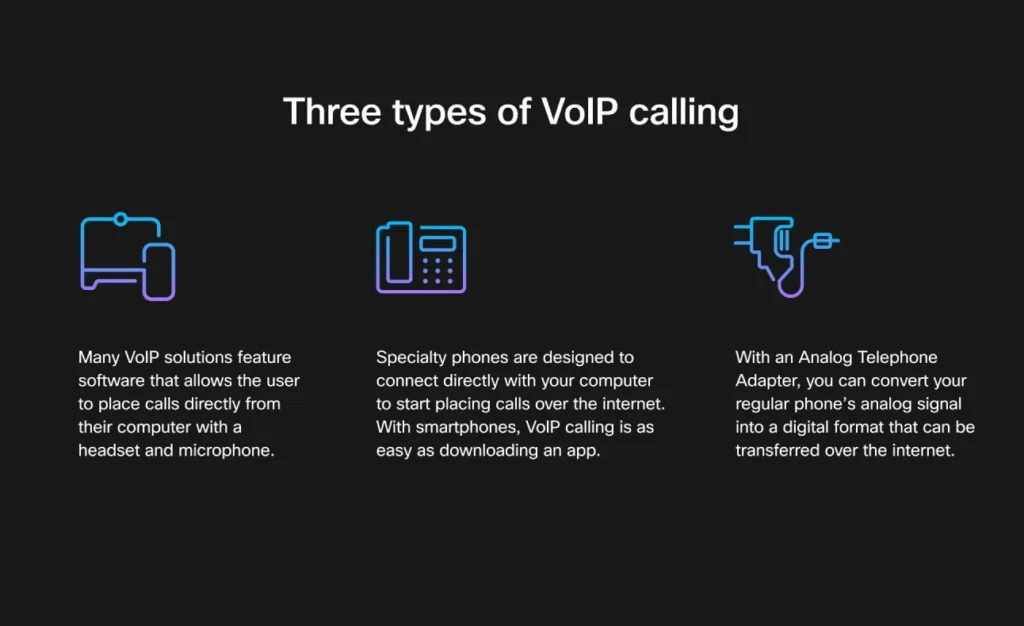
Hosted System
A hosted VoIP system involves having a third-party provider remotely manage your cloud phone system. This way, your business doesn’t have to maintain IP PBX equipment or install updates. Instead, your provider manages the VoIP phone system for you. Hosted VoIP systems are the best option for small businesses due to their highly flexible pricing structure. (All of the providers on our list host VoIP systems.)
On-Premise System
A On-Premises PBX system means that you deliver your Voice over IP service through an IP PBX or SIP trunk installed on your premises. Some businesses find that SIP trunking saves them money in the long run (compared to a hosted VoIP provider). On-Premises systems are the best option for larger businesses because they can use a single equipment room to power the entire building.
Managed System
A managed system is a combination of a hosted VoIP system and an on-premise system. Your provider assigns an IT and VoIP specialist to configure and manage your on-premise settings and internet connection. A managed system provides greater flexibility and control over your VoIP network settings, while freeing you from having to maintain it yourself.
A managed system is ideal for large businesses because it gives you access to a dedicated professional who can fully dedicate their services to solving any issues that arise.
Does Switching to VoIP Save Money?
Switching from a traditional switchboard to VoIP will save your business money with lower installation and maintenance costs, remote staff without personal equipment, easy scalability, and a single phone bill.
Cordless Costs Less to Setup and Maintain
Fixed systems require a large local PBX system, phone booths, and desk phones for each agent, while hosted VoIP systems do not. You can install a hosted VoIP phone system without purchasing new equipment.
Users can access all of the features of VoIP, such as calling, messaging, video conferencing, and routing, from their own computers and mobile devices. In addition, your provider handles maintenance and upgrades.
Remote Workforce Equals Reduced Overhead
VoIP makes it easy to support a remote team. You can provide employees with virtual phone numbers, allowing them to make calls, send messages, and manage all business matters remotely.
By using a remote team with VOIP, your company saves on the costs associated with a private office: electricity, water, heating, air conditioning, and more.
No Paying Through the Roof to Move or Expand
VoIP services are flexible, portable, and scalable, saving you money and hassle when your business changes location, adds a new site, or adds new users.
If you move offices, your VoIP phone service doesn’t change. Agents can keep their numbers and continue to use the same devices. Adding a new office simply involves obtaining new DID numbers from your VoIP phone company. These can be based on your new office or an area code of your choice. You can simply purchase a new subscription to add new users, with no IT setup or configuration required.
One Communications Bill
Instead of managing multiple connection accounts, VoIP users pay a single monthly subscription. This multi-channel subscription typically costs less than $30 per user per month.
Calculating the Cost Savings of VoIP
To calculate how much you can save by switching from a landline to VoIP, first add up all of your communication costs and overhead: equipment, service, electricity, monthly phone bills, and text messaging.
Next, decide which pricing plan best suits your needs based on the features and channels you plan to use. The table below will help you compare the costs of a traditional landline phone and a VoIP phone system.
*Please note that this is an optional extra for VoIP users, but is mandatory for traditional landlines.
*Cost varies by country. With both VoIP and traditional systems, calls to mobile phones are more expensive than calls to landlines.
VoIP has clear advantages over traditional PBXs, considering the installation, equipment, features, and cost of calls. VoIP can save large businesses tens of thousands of dollars annually.
How Do VoIP Phones Work Compared to Landline Phones?
While landlines use the PSTN to transmit voice over wires, VoIP telephony uses the Internet to send voice data packets.
Landlines must be connected to the PSTN using wires and connectors, which limits their use in your office. After a call, the voice signal is routed over the cable through a series of global switches before reaching its destination.
VoIP audio data is transmitted over the Internet to your business, which in turn sends it to the recipient via a cellular network, the Internet, or a landline.
More VoIP Providers We Reviewed
In addition to the ten services on lisInternete, we also reviewed the following residential and business VoIP providers:
- Nextiva: The Best Internet Collaboration Platform
- Optimal Business: Ideal for call management and three-way conferencing
- Spectrum VoIP: Ideal for HD voice
- CenturyLink Business: Ideal for call filtering and blocking
OnSIP: Ideal for call and queue management
We Thought You Might Find These Articles Interesting
- Solving VoIP Problems: Ten Effective Solutions
- IVA vs. IVR: Which is Best for Your Business?
- 10 Benefits of Choosing VPC VoIP for Small Businesses
Connect to Customers and Grow Your Business With VoIP
Compared to traditional PBX phone systems, VoIP benefits your business in almost every way: easy setup, low monthly costs, scalability, unlimited calls, multiple communication channels, and more.
While many VoIP providers offer exceptional functionality, each has unique features and pricing plans. Consider your business type, calling territory, and use cases, and choose the provider that best suits your needs.
Our recommendations for the 10 best VoIP companies and providers are: R



